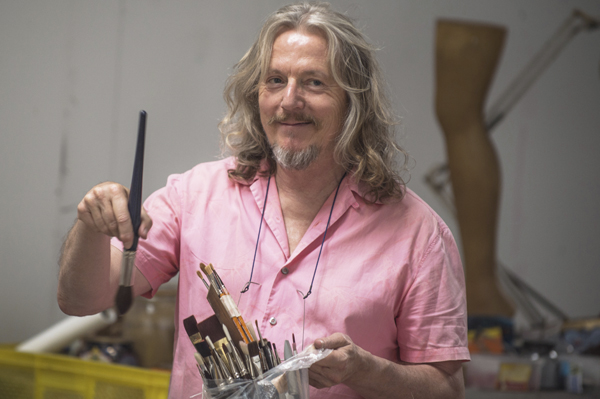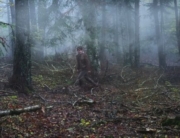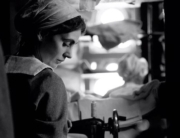Beltracchi: The Art of Forgery is more straightforward than earlier explorations of skullduggery in the art market, from Harry Moses’s Who the #$&% Is Jackson Pollock? (2006) to last year’s Art and Craft or Orson Welles’ classic F for Fake (1973). First of all, Wolfgang Beltracchi is guilty; he and his wife Helene made millions forging and selling at least dozens of early 20th-century paintings for almost 40 years.
While out of prison during the day, the German couple calmly explain to director Arne Birkenstock, son of their defense attorney, how they so successfully perpetuated fraud. What made possible their scam? Too much money seeking too few masterpieces encouraged slippery ethics. A police detective methodically describes the criminal investigation, and the buyers and sellers they fooled—auctioneers, appraisers, collectors, curators, dealers, gallery owners—sputter their fury. One of these one-percenters, illogically, even recommends applying Sharia law.
The Beltracchis look like two aging hippies (he’s now 61), with long flowing hair and go-with-the-flow nonchalance. (He was already painting fakes when he met Helene in February 1992.) Together, hand in hand, they show how they would search flea markets for old, anonymous canvases and frames with historical gallery identification to paint over. They then would go home to a beautiful modern villa or to his soaring artist studio. Their elegant surroundings were not just a benefit but also a convincing cover for her family’s fictional art collection.
They are very well informed about art and the market to come across as credible collectors. Wolfgang (née Fischer) grew up accompanying his father on his rounds as a church conservator and restorer, who had his son keep busy sketching—until the son’s skills surpassed his. Wolfgang found that the Old Masters took too much time to copy properly. (This doesn’t stop him from bragging to an interviewer: ““I can paint anything. Leonardo? Of course. But why? You couldn’t sell it.”) After dropping out of art school, he kept up with the field and gradually realized that there tended to be a pre-World War I gap in the oeuvres of hot-selling painters.
Sometimes works were known by name and even description but had been missing over the years of wars. Sometimes specialists hypothesized that gifted artists were probably prescient about the changes that would overtake the continent, and scholars were hot to find the works with those hints of premonitions. Wolfgang casually demonstrates how he would go to the locales the artists were known to frequent and paint from the same scenery, adding in touches that pointed toward the future. So Wolfgang, in effect, gave the art historians what they were looking for, and these authenticators, called in by auction houses and institutions, were pleased to confirm their own theories, with the benefit of earning a nice commission on the sales. (Not mentioned in the film is that the European art market was for decades notably avoiding asking too many questions about provenance, as seen in Portrait of Wally and Woman in Gold, to avoid any taint from Nazi connections or lawsuits from Jewish families.) Particular attention focuses on Werner Spies, the former museum director of the Centre Pompidou in Paris and an expert on Max Ernst, who declared seven fakes to be the real deals. While Spies was later successfully sued by one collector, Beltracchi is proud to have manipulated what he sees as a self-serving business where suspicion is bad for business.
His downfall came when his interpretation of a long missing Heinrich Campendonk known as Red Painting with Horses, 1914, sold for a record 2.8 million Euros at an auction in 2006. It attracted new verification analysis that caught his rare error. (Yeah, I hadn’t heard of this German artist from “The Blue Rider” school either, so any purchase price would sound like a lot to me. Steve Martin bought one of Wolfgang’s fakes for $860,000 in 2004.)
The cheated purchasers are surprisingly philosophical (they did receive restitution). The elderly couple, living in an art-filled home much like the Beltracchis’, confess to admiring the painting, and if they still had it, they would put it in their bedroom closet to see it every day. Andy Warhol would have appreciated the irony if it had stayed in its original position across from one of his Polaroid portraits.
The Beltracchis’ adult children are still stunned and mystified by the source of their parents’ comfortable lifestyle and luxuriant vacations (shown in a lot of family photos). Some details are left vague, such as the wife’s negotiations with a dealer who helped them (and who was also arrested) and their final sentences. Other than the 14 paintings that were the subject of the 2011 court case over the $21 million they were paid, Wolfgang has still not identified all of his fakes that are probably hanging on moguls’ and museum walls. I was reminded of another fraud authenticated by an expert, when in the muscial My Fair Lady the late Theodore Bikel pronounces of the gussied-up Eliza Doolittle, “She’s Hungarian!” I walked out of this film chuckling and humming one of its tunes.

















Leave A Comment